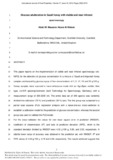JavaScript is disabled for your browser. Some features of this site may not work without it.
| dc.contributor.author | Mouazen, Abdul Mounem | |
| dc.contributor.author | Al-Walaan, Noura | |
| dc.date.accessioned | 2016-10-26T12:45:17Z | |
| dc.date.available | 2016-10-26T12:45:17Z | |
| dc.date.issued | 2014-07-14 | |
| dc.identifier.citation | Mouazen, A. M., Al-Walaan, N (2014) Glucose adulteration in Saudi honey with visible and near infrared spectroscopy, International Journal of Food Properties, Vol. 17, Iss. 10, pp. 2263-2274 | en_UK |
| dc.identifier.issn | 1094-2912 | |
| dc.identifier.uri | http://dx.doi.org/10.1080/10942912.2013.791837 | |
| dc.identifier.uri | http://dspace.lib.cranfield.ac.uk/handle/1826/10875 | |
| dc.description.abstract | This article reports on the implementation of visible and near infrared spectroscopy for the detection of glucose concentration in a mixture of Saudi and imported honey samples adulterated by glucose syrup of five concentrations: 0, 5, 12, 19, and 33 g/100 g. Honey samples were scanned in trans-reflectance mode with an AgroSpec mobile, fibre type, visible and near infrared spectrophotometer (tec5 Technology for Spectroscopy, Germany), with a measurement range of 305–2200 nm. The entire data set of 345 spectra was randomly divided into calibration (70%) and prediction (30%) sets. The first group was subjected to a partial least squares regression analysis with a leave-one-out cross-validation to establish a calibration model for the prediction of glucose concentration, whereas the second group was used to validate the partial least squares model. For the cross-validation, the values for root mean square error of prediction, coefficient of determination, and ratio of prediction deviation, which is the standard deviation divided by root mean square error of prediction were 4.52 g/100 g, 0.85, and 2.53, respectively. A slightly lower range of accuracy was obtained in the prediction set, with root mean square error of prediction, coefficient of determination, and ratio of prediction deviation values of 5.56 g/100 g, 0.78 and 2.06, respectively. The results achieved suggest that the visible and near infrared spectroscopy is a powerful technique for the quantification of glucose adulteration in Saudi honey. | en_UK |
| dc.language.iso | en | en_UK |
| dc.publisher | Taylor & Francis | en_UK |
| dc.rights | Published by Taylor & Francis. This is the Author Accepted Manuscript. This article may be used for personal use only. The final published version (version of record) is available online at 10.1080/10942912.2013.791837. Please refer to any applicable publisher terms of use. | en_UK |
| dc.subject | Honey | en_UK |
| dc.subject | Adulteration | en_UK |
| dc.subject | Visible and near infrared spectroscopy | en_UK |
| dc.subject | Glucose | en_UK |
| dc.subject | Saudi Arabia | en_UK |
| dc.title | Glucose adulteration in Saudi honey with visible and near infrared spectroscopy | en_UK |
| dc.type | Article | en_UK |
Files in this item
This item appears in the following Collection(s)
-
Staff publications (SWEE) [2807]
